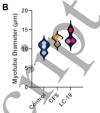Looking at the researchers:
It's good to hear @DMissa's comments about the primary author. Here's an article about her. She's had experience with engineered muscle tissue experiments before.
The senior author is at ICREA and looks to have been working with engineered tissue for a long time. He has a number of publications about muscle diseases, muscle dystrophy. The researcher we know interested in FSHD genetics might know something about this team.
Seeing Jesus Castro-Marrero on the author list rang a few alarm bells, as we have seen some less than great research from him, with some concerns about management of conflicts of interest in relation to supplement manufacturers. But here, it looks as though he was not involved in the analysis. It's possible that he was brought in as the ME/CFS expert and didn't have much involvement.
I like the background of some of the authors, in rare diseases and inherited metabolic disorders and muscular diseases. The funding sources looked fine. Some of the work associated with Professor Morten hasn't had quite the level of rigour that I would have liked to have seen. I guess though, the number of academics I'd like to see as reviewers of ME/CFS research is unfortunately very small.
It would be great if our Spanish members or others who know this team could give us some more background. Even better if the researchers would like to come to the forum to talk about their work. I hope that they won't be put off by the scrutiny, it's a protective mechanism, we don't want to get too excited. We are looking for the problems.
If replicated, these findings could be very important. It would be wonderful to have validation for the odd feeling of intermittent loss of power in muscles.
I wonder what the researchers are planning to do next.
Authors: Sheeza Mughal1,8*, Félix Andújar-Sánchez2,3,4, Maria Sabater-Arcis1 , Glória Garrabou2,3,4 , Joaquim Fernández-Solà3 , Jose Alegre-Martin5,6, Ramon Sanmartin-Sentañes5,6 Jesús Castro-Marrero6 , Anna EsteveCodina7,8 , Eloi Casals7,8 , Juan M. Fernández-Costa1*, and Javier Ramón-Azcón1,9*
Affiliations:
1Institute for Bioengineering of Catalonia (IBEC), Barcelona Institute of Science and Technology (BIST); Barcelona
2Inherited Metabolic Disorders and Muscular Diseases Research Group, Institutd’Investigacions Biomèdiques August Pi i Sunyer (IDIBAPS) and Faculty of Medicine and Health Sciences, University of Barcelona, 08036 Barcelona
3Department of Internal Medicine, Hospital Clinic of Barcelona, 08036 Barcelona
4CIBERER—Spanish Biomedical Research Centre in Rare Diseases, 28029 Madrid
5Division of Rheumatology, Vall d'Hebron University Hospital, Universitat Autònoma deBarcelona, 08035 Barcelona
6Unit of Research in ME/CFSyalgic Encephalomyelitis/Chronic Fatigue Syndrome and Long COVID, Division of Rheumatology Research, Vall d'Hebron Research Institute, Universitat Autònoma de Barcelona, 08035 Barcelona
7Centro Nacional de Análisis Genomico (CNAG), Baldiri Reixac 4, 08028 Barcelona
8Universitat de Barcelona (UB), Barcelona, Spain
9ICREA-Institució Catalana de Recerca i Estudis Avançats; Barcelona, Spain
Acknowledgements
We extend gratitude to Dr Benedicte Chazaud from the Institut NeuroMyoGène, Lyon, France, for providing us the human immortalized muscle precursor cells and to the MicroFabSpace and Microscopy Characterization Facility, Unit 7 of Unique Scientific and Technical Infrastructures (ICTS) ‘NANBIOSIS’ from Networking Biomedical Research Centre-Bioengineering, Biomaterials and Nanomedicine (CIBER-BBN) at the Institute for Bioengineering of Catalonia (IBEC) for their technical support.
We would also like to acknowledge the thorough critique and suggestions on this manuscript presented by Dr. Adolfo López de Munain Arregui from the Clinical Neurosciences Unit of Policlínica Gipuzkoa, San Sebastian, Spain and Professor Dr. Karl Morten, University of Oxford John Radcliff Hospital, The United Kingdom. Finally, we would also like to express our appreciation to the entire team of Biosensors for Bioengineering group at IBEC for their valuable
feedback during the manuscript preparation process.
It's good to hear @DMissa's comments about the primary author. Here's an article about her. She's had experience with engineered muscle tissue experiments before.
The senior author is at ICREA and looks to have been working with engineered tissue for a long time. He has a number of publications about muscle diseases, muscle dystrophy. The researcher we know interested in FSHD genetics might know something about this team.
Seeing Jesus Castro-Marrero on the author list rang a few alarm bells, as we have seen some less than great research from him, with some concerns about management of conflicts of interest in relation to supplement manufacturers. But here, it looks as though he was not involved in the analysis. It's possible that he was brought in as the ME/CFS expert and didn't have much involvement.
I like the background of some of the authors, in rare diseases and inherited metabolic disorders and muscular diseases. The funding sources looked fine. Some of the work associated with Professor Morten hasn't had quite the level of rigour that I would have liked to have seen. I guess though, the number of academics I'd like to see as reviewers of ME/CFS research is unfortunately very small.
It would be great if our Spanish members or others who know this team could give us some more background. Even better if the researchers would like to come to the forum to talk about their work. I hope that they won't be put off by the scrutiny, it's a protective mechanism, we don't want to get too excited. We are looking for the problems.
If replicated, these findings could be very important. It would be wonderful to have validation for the odd feeling of intermittent loss of power in muscles.
I wonder what the researchers are planning to do next.
Last edited:





